Toyota Belta
| Toyota Belta (XP90) | |
|---|---|
 2005 Toyota Belta (XP90; pre-facelift, Japan) | |
| Overview | |
| Manufacturer | Toyota |
| Also called |
|
| Production |
|
| Model years | 2007–2012 |
| Assembly |
|
| Designer | Takashi Hagino (2003) |
| Body and chassis | |
| Class | Subcompact car |
| Body style | 4-door sedan |
| Layout |
|
| Platform | Toyota B platform |
| Related |
|
| Powertrain | |
| Engine | |
| Transmission |
|
| Dimensions | |
| Wheelbase | 2,550 mm (100.4 in)[3] |
| Length | 4,300 mm (169.3 in)[3] |
| Width | 1,690–1,700 mm (66.5–66.9 in)[3] |
| Height | 1,460–1,480 mm (57.5–58.3 in)[3] |
| Kerb weight | 990–1,120 kg (2,183–2,469 lb) |
| Chronology | |
| Predecessor |
|
| Successor |
|
The Toyota Belta (Japanese: トヨタ・ベルタ, Toyota Beruta), referred to in North American and Australian markets as the Yaris and in Asian markets as the Vios, is a subcompact sedan manufactured by Toyota.
The successor to the discontinued Platz sedan, the Belta has increased in size over the previous generation such that its interior volume is comparable to the E120 series Corolla. The Belta went on sale in Japan on 28 November 2005 equipped with 1.0 to 1.3 L engines and was available at Toyota dealership Toyopet Store.[4] Export sales began in 2006, with most markets receiving a 1.5 L 1NZ-FE engine as standard fitment.[5]
The Belta is sold as the second generation Vios in China, Taiwan and selected Southeast Asian countries. In the United States, Canada, Middle East and Australia, it is marketed as the Yaris Sedan, replacing the Echo sedan that was built in Japan.
The name "Belta" is a contraction of the Italian words "bella gente", or "beautiful people".[4][6]
Drivetrain[]
The XP90 Vitz and Belta share underpinnings with each other including the drivetrain and platform. However, while the Vitz was designed at Toyota's French design studios, the Belta was designed at Toyota's Japanese design studios—design projects for similar cars marketed toward different demographics. While the outgoing Vitz and Platz models look and feel very much alike, the newer Vitz hatchback and Belta sedans are more subtly related. No sheetmetal is shared between the two, and although both have a similar centralized dashboard design (Toyota's efforts to standardize the design for all markets, left or right hand drive) there are some cosmetic differences. The Belta is the only subcompact sedan which is designed, built and sold in Japan, and has no direct competitors in the Japanese domestic market, as the Vitz's competitors did not offer sedan versions at the time.
Markets[]
Asia[]
For most Asian markets (except Japan, Hong Kong and Macau), the Belta was sold as the second generation Vios which was built and assembled in Malaysia, the Philippines and Thailand. It was launched in April 2007. For the Japanese, American and Middle Eastern markets (except Israel, Morocco, Korea, Russia and Europe), the Belta was built in Japan.
The model code for cars with 1.5 L 1NZ-FE engines is "NCP93" and is only available where the Yaris/Vios is marketed. As was the first generation Vios, the second generation Vios was assembled at Thailand's Toyota Gateway Plant and also at the Philippines Santa Rosa, Laguna Plant.
The second generation Vios was the best-selling car in Southeast Asia in 2009.[7]
Japan[]
The Japanese market Belta had three engine variants available, namely the 53 kW (71 hp) 1.0 L 1KR-FE straight-three engine and two variants of the 1.3 L 2NZ-FE/2SZ-FE engine rated at 63 kilowatts (84 hp). The 2SZ-FE engine comes with Super CVT-i transmission while the 2NZ-FE engine has a Super ECT transmission. An optional S Package is also available across the three variants.

2005 Toyota Belta (pre-facelift, Japan)
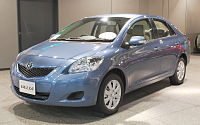
2008 Toyota Belta (facelift, Japan)

2008 Toyota Belta (facelift, Japan)
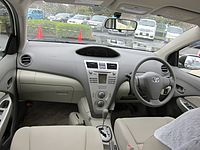
Toyota Belta interior
China[]
The second generation Vios was introduced to China in 2008. The major difference of the Vios in China is that the larger capacity models are powered by the 1.6 L 4ZR-FE engine with Dual VVT-i. The engine system adjusts timing on both intake and exhaust camshafts.
Unlike other markets, Mainland China uses version naming as follows:[8]
- 1.3GL-i (Standard - automatic or manual)
- 1.3GL-i Special (Standard - automatic or manual)
- 1.6GL-i Special (Leather seats with sunroof)
- 1.6GL-S Sports AT
- 1.6GLX-i (Sports - like GL-S, but with kit and dark interior)

Toyota Vios (pre-facelift, China)

Toyota Vios (pre-facelift, China)
Philippines[]
In the Philippines, the second generation Vios was launched in 2007 in 3 trim levels: 1.3 J, 1.3 E and 1.5 G. All trim levels were available with a 5-speed manual transmission, the G trim also with a 4-speed automatic transmission.
The 1.5 G Limited XX Edition was released in July 2008. This is the same as the G trim, but came with HID headlights, 17-inch 10-spoke alloy wheels and a small rubber spoiler. The 1.5 S also got this spoiler and different 17-inch Rota Bolognia Mags with 205/45 tires. The G XX Limited and S trims were released in different colour schemes.
A facelifted model was launched on 6 April 2010, with a redesigned front grille, redesigned headlamp and tail lamp assemblies, and redesigned 15-inch alloy wheels (for the G trim). It was available in three trim levels: the base 1.3 J mated to a 5-speed manual transmission, the 1.3 E, with the choice of a 5-speed manual or the now available 4-speed automatic transmission, and the 1.5 G, with the choice of a 5-speed manual or 4-speed automatic transmission.
For 2012, a 1.3 L engine for the G trim was released, and it was mated to a 4-speed automatic transmission, then later a 5-speed manual transmission equipped with fog lights, steering wheel audio controls and power adjusting side mirrors. Also available from 2012 was a trim lower than the J trim called the 1.3 Base which came only in a 5-speed manual transmission. In 2013, the 1.5 TRD Sportivo trim was released.
During its entire period on the market, the second generation Vios was the best selling car in the Philippines helping Toyota to maintain its status as the best selling brand in the country.[9][clarification needed]
Indonesia[]
The second generation Vios was officially launched to the Indonesian market on 11 April 2007. The Indonesian Vios can be distinguished from other countries' models with its V-shaped grille ornament, which is optional for the Yaris Hatchback. Like the outgoing NCP42, the NCP93 Vios is offered in E (with manual transmission only) and G (with either manual or automatic transmission) trim levels.
All trim levels come equipped with ABS and analog instrument panel. The E trim has rear drum brakes and the G trim comes with all discs. The higher-grade G trim has standard front and rear fog lamps, audio control on the steering wheel, auto-leveling HID headlamps, multi-information display and back sonar. Start/Stop push button is only available on the G trim with automatic transmission.
For the facelifted model, the Indonesian Vios did not feature the V-shaped grille ornament, giving it the same appearance as other countries' models. In addition to the regular trim levels, there is also a TRD Sportivo model based on the G trim which adds an all-round body kit to the exterior and comes fitted with an AV DVD player and navigational capabilities.

2007 Toyota Vios 1.5 G (NCP93; pre-facelift, Indonesia)
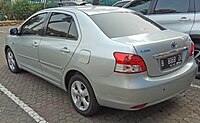
2007 Toyota Vios 1.5 G (NCP93; pre-facelift, Indonesia)

2011 Toyota Vios 1.5 G (NCP93; facelift, Indonesia)
Malaysia[]
The second generation Vios was unveiled in Kuala Lumpur, Malaysia on 5 October 2007, two weeks ahead of its official launch on 19 October 2007.[10] The Vios is powered exclusively by the 1NZ-FE 1.5 L four-cylinder engine with VVT-i, which included a redesigned air intake and exhaust system to improve low to mid-range torque. It was also fitted with the Super ECT four-speed automatic with the same gear ratios as its predecessor, but with improved programming for the transmission control unit.[10] Electric power steering was offered in place of the hydraulic system in its predecessor.[10] The second generation Vios was made available in four trim levels for the Malaysian market: J, E, G and S.
The J is the base version. It was initially unavailable at the Malaysian Vios launch in October 2007, but was introduced on 1 July 2008, offering a choice of either 5-speed manual or 4-speed automatic transmissions.[11]
The E and G differ mostly in terms of equipment levels and are mechanically identical, both sharing the 4-speed Super ECT transmission.[12] On 29 June 2011, the G Limited was introduced offering a body kit, 15-inch alloy wheels and leather seats.[13]
The S is an addition featuring cosmetic enhancements, including a front bumper spoiler, side skirts, rear skirt and a bootlid spoiler.[12] The interior received a dark grey/black trim treatment and an Optitron meter with a multi-information display, as opposed to the E and G trims' conventional backlit display. The S trim was the most expensive Vios variant.[12] On 17 June 2009, UMW Toyota launched the Vios 1.5 TRD Sportivo which effectively replaced the S trim.[14] It featured a body kit, Enkei wheels, various interior trim improvements and an optional sports suspension kit. The Vios TRD Sportivo was updated on 29 June 2011, featuring a redesigned grille, unique alloy wheels and leather seats.[13]
On 15 April 2010, the Vios received a facelift in Malaysia, offering mostly cosmetic improvements.[15] The Vios was updated on 21 June 2012 in response to Honda Malaysia's facelift of the City, with appearance changes without significant mechanical improvements.[16]
All model grades included ABS with EBD and BA at the October 2007 launch, but the E trim was only offered with a single driver's airbag, whereas the G and S trims had an additional passenger airbag.[12] The J trim had no airbags at all upon its July 2008 launch, but was nonetheless offered with ABS + EBD and BA.[11] The J trim later received a driver's airbag in its 2010 facelift[15] and a front passenger airbag in its 2012 update.[16]
The Malaysian Vios is assembled locally by ASSB, a subsidiary of UMW Toyota, in Shah Alam, Selangor. The Vios has since become the best selling non-national badged vehicle in Malaysia, achieving record sales in 2012.[17]

2008–2010 Toyota Vios 1.5 J (NCP93R; pre-facelift, Malaysia)

Toyota Vios 1.5 G (NCP93R; pre-facelift, Malaysia)

Toyota Vios 1.5 G (NCP93R; pre-facelift, Malaysia)

2010 Toyota Vios 1.5 G with TRD Sportivo body kits (NCP93R; pre-facelift, Malaysia)

2010 Toyota Vios 1.5 G with TRD Sportivo body kits (NCP93R; pre-facelift, Malaysia)

2011 Toyota Vios 1.5 J (NCP93R; facelift, Malaysia)

2011 Toyota Vios 1.5 J (NCP93R; facelift, Malaysia)
Singapore[]
In Singapore, the Vios was sold in the base model J, the mid-level E and the top-of-the-line G trim levels, and later the TRD Sportivo model.
The J trim is the lowest version and comes standard with a CD/MP3/WMA player with 4 speakers, keyless entry, ABS/EBD/BA (on front disc brakes only), driver-only SRS airbag and interior fabric with dark grey colour seats.
The E trim is the only manual variant after the local dealer discontinued the manual J variant in Singapore. The E Classic includes an additional SRS airbag for the front passenger and side moulding. There is another variant of the E trim known as the Elegance that includes leather seats and fog lights.
The G trim is the top-of-the-line version available in Singapore and comes with an automatic transmission. The G trim adds a 6-speaker CD/MP3 player, optitron meters, four-wheel disc brakes, and 60:40 split foldable rear seats.
Optional "Sport" and “Racing” bodykit were offered and aftermarket alloy wheels that were added by the Toyota dealership in Singapore (Borneo Motors). In 2012, three colours were added – Grey Metallic (1G3), Attitude Black Mica (211) and Blackish Red Mica (3R0) – to make 7 colours in total. In December 2012, Borneo Motors (Singapore) introduced a "Sportivo" variant based on the E grade, consisting of a TRD sports kit and 15” TRD multi-spoke alloy rims. In 2013, only the E grade remained in the lineup for the Vios.

Thailand[]
Thailand, which currently manufactures the Vios, is offered in three trim levels (J, E and G), as well as two limited edition trim levels (G Limited and S Limited). Thailand is currently the only country that offers all existing grades of the Vios, while export markets are only given a fraction of the Thai range in varying combinations. In addition, certainly the range of equipment in Thai Vios' differs from those in export versions.
The J is the basic trim level of the second generation Vios, offering a CD/MP3/WMA player with four speakers, an optional keyless entry with TVSS, ABS/EBD/BA, 15-inch steel wheels with hubcaps, rear fog lamps and interior fabric with dark grey colour seat.
The E is a mid-level trim featuring a keyless entry with TDS, an option between dark grey or ivory-coloured seat fabrics, optional driver and front passenger SRS airbags, front and rear fog lamps, 15-inch sports alloy wheels and side moulding.
The G trim features an unchangeable 6 speaker CD/MP3/WMA player, leather seating in either dark grey or ivory, driver and front passenger SRS airbags, a multi-functional steering wheel, 15-inch sports alloy wheels front and rear fog lamps, side moulding, a blue "Optitron" panel with a multi-information display and 60:40 fold-down rear seats.
The G Limited trim includes a keyless and smart entry with TDS, a Start/Stop push button, an immobilizer key and a body kit to the exterior.
The limited edition S Limited trim features a "Wrap-Around Aeropart" body kit, an orange "Optitron" panel with a multi-information display, high intensity discharge headlamps with automatic height adjustment and all-wheel disc brakes.
Audio systems in all second generation Vios trim levels are equipped with ASL (Auto-Speed Sound Levelizer), which detects and compensates for changes in external noise levels, adjusting volume and tone controls automatically based on the car's speed.
Toyota Thailand has also exported the Vios to the Middle East, Australia and South Africa, where it is sold as the Yaris.
The second generation Vios has been campaigned in One Make Races in Bangkok, Thailand.[18]

2007 Toyota Vios 1.5 E (NCP93R; pre-facelift, Thailand)

2007 Toyota Vios 1.5 E (NCP93R; pre-facelift, Thailand)
North America[]

The US version of the Belta was badged Yaris sedan and went on sale in April 2006 for the 2007 model year. Conventional trim levels are replaced by the more modular convenience, power, and all-weather guard packages. However, the Yaris sedan is also available as the Yaris S, which has standard convenience and appearance packages fitted as standard. The power package on the Yaris sedan offers alloy wheels as an option. Side airbags were optional. The Yaris sedan was sold alongside the Yaris 3-door hatchback, and from 2009 onwards only the Yaris 5-door was available as a hatchback.[19]
The Canadian version of the Yaris sedan, is based on the US-market Yaris S with power and all-weather guard packages, but with standard 14-inch (360 mm) wheels. The regular CE, LE and RS trims used in the Canadian Yaris hatchback are replaced in the Yaris sedan by option packages of B, C, D or Aero types. The B adds 15-inch (380 mm) all-season tires, chrome trim on the decklid, front and rear splash guards, colour-keyed door handles, blacked-out side window frames, keyless entry and power door locks; the C adds ABS, air conditioning, power windows, colour-keyed mirrors and power mirrors; the D adds both side and side-curtain airbags; the Aero adds alloy wheels, wheel locks, a rear spoiler and a body kit. The Aero, however, has neither air conditioning nor side airbags. The Canadian model lacks the two-tone interior, pseudo-metallic trim on the door panels and the new audio system controls (instead it uses an old design) found on the Japanese and American models.
The 2007 Yaris sedan received EPA fuel economy ratings of 40 mpg‑US (17.0 km/L) on the highway and 34 mpg‑US (14.5 km/L) in the city, with a fuel capacity of 42 L (11.1 US gal). However, because the EPA changed the way they calculate fuel economy, ratings were revised for the 2008 model year and the Yaris is now rated at 29 mpg‑US (12.3 km/L) city/36 mpg‑US (15.3 km/L) mpg highway for the manual transmission, and 29 mpg‑US (12.3 km/L) mpg city/35 mpg‑US (14.9 km/L) mpg highway for the automatic version.[20]
For the 2009 model year, all Yaris sedans received updated styling with a new grille, alloy designs, interior fabric, standard side curtain airbags and anti-lock brakes. There are also options such as a leather-wrapped steering wheel/shift knob and satellite radio.
Australia[]
In Australia, it is known as the Yaris sedan and is sold alongside the Vitz-based Yaris hatchback.[21] The Yaris sedan is available only in a 1.5 L 1NZ-FE 81-kilowatt (109 hp) petrol engine. There were two variants of the model, namely the YRS and YRX, with the former being the model with the basic necessities. The YRX model features an all-round body kit and was available in an automatic transmission or 5-speed manual transmission.
The Australian version of the Yaris sedan uses orange blinker bulbs with clear lenses instead of orange blinker lenses.
At the end of mid-year 2015, the Australian version Yaris sedan was discontinued due to poor sales with over 27 percent drop.[22] It was then phased out with no direct replacement for the Australian market.

2007 Toyota Yaris YRS (NCP93R; pre-facelift, Australia)

2007 Toyota Yaris YRS (NCP93R; pre-facelift, Australia)
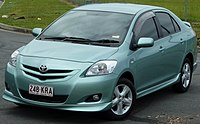
2009 Toyota Yaris YRX (NCP93R; pre-facelift, Australia)

2009 Toyota Yaris YRX (NCP93R; pre-facelift, Australia)
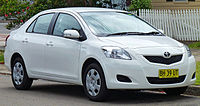
2008–2010 Toyota Yaris YRS (NCP93R; facelift, Australia)

2011 Toyota Yaris YRS (NCP93R; facelift, Australia)

Interior
Safety[]
United States[]
Standard safety features include airbags, front seatbelt pretensioners, and head restraints for all seating positions. Side-impact airbags, side curtain airbags and ABS are optional on 2007–2008 models. Beginning in 2009, front and rear row side curtain airbags along with front seat-mounted torso side airbags and anti-lock brakes became standard.[23] Stability control was unavailable on all models until the 2010 model year when it became standard.
According to the US Insurance Institute for Highway Safety (IIHS) the Yaris sedan received a "Good" overall score in the frontal crash test and a "Good" overall score in the side impact test on models equipped with side airbags but a "Poor" overall score on models without side airbags.[24][25] In their roof strength evaluation the Yaris is rated "Acceptable" with a strength-to-weight ratio of 3.78.[26]
U.S. National Highway Traffic Safety Administration (NHTSA) Yaris sedan crash test ratings:
| 2008 MY, no side airbags[27] | 2009 MY, with side airbags[28] | |
|---|---|---|
| Frontal driver | ||
| Frontal passenger | ||
| Side driver | ||
| Side rear passenger | ||
| Rollover |
Southeast Asia[]
ASEAN NCAP test results for a RHD, 4-door sedan on a 2012 registration:[29]
| Test | Score |
| Adult occupant protection: | |
| Child occupant protection: | 48% |
Discontinuation[]
In June 2012, the Japanese-market Belta was discontinued and replaced by the E160 series Corolla, and it was dropped in the U.S. and Canada without a direct sedan replacement; only the XP130 series Vitz-based Yaris Liftback would be offered in those countries for several years. However, the Belta was still produced in Japan for export to Mexico and Australia until it was discontinued in both countries in 2016.
For the Asian market, the XP150 series Vios was launched in 2013 as the sedan counterpart to the XP150 series Yaris hatchback.
References[]
- ^ "Affiliates (Toyota wholly-owned subsidiaries)-Toyota Motor East Japan, Inc". Toyota Motor Corporation. 2012. Retrieved 2014-07-21.
- ^ 天津一汽丰田汽车有限公司 [Tianjin FAW Toyota Motor] (in Chinese). TFTM. Retrieved 2010-10-17.
- ^ Jump up to: a b c d "2007 Toyota Vios Car Information Singapore". sgCarMart. Retrieved 2016-04-14.
- ^ Jump up to: a b "Toyota Launches New Vehicle 'Belta' in Japan" (News Release). Toyota Motor Corporation. 2005-11-28. Archived from the original on 2010-08-01.
- ^ "2007 Toyota Yaris Review and Specs". JB car pages. Retrieved 2008-08-13.
- ^ "Vehicle Lineage Chart Data: Origin of a car's name". Toyota Motor Corporation.
- ^ "Great Toyota Vios". Retrieved 2012-12-29.
- ^ "2nd generation Vios in China". chinaautoweb.com. Retrieved 2013-11-23.
- ^ Gasnier, Matt (2010-01-10). "Philippines 2008-2009: Toyota Vios now ahead of Innova". Best Selling Cars. Retrieved 2014-06-01.
- ^ Jump up to: a b c Paul Tan (2007-10-05). "2007 Toyota Vios details and photos". paultan.org. Retrieved 2007-10-06.
- ^ Jump up to: a b Paul Tan (2008-07-01). "New 2009 Toyota Vios J Spec Manual and Auto". paultan.org. Retrieved 2013-11-17.
- ^ Jump up to: a b c d Paul Tan (2007-09-12). "New Toyota Vios line-up teaser with prices". paultan.org. Retrieved 2013-11-17.
- ^ Jump up to: a b Danny Tan (2011-06-29). "Toyota Vios 1.5G Limited launched, TRD Sportivo updated". paultan.org. Retrieved 2013-11-17.
- ^ Paul Tan (2009-06-17). "Toyota VIOS 1.5 TRD Sportivo arrives in Malaysia, replaces the Vios 1.5S!". paultan.org. Retrieved 2013-11-17.
- ^ Jump up to: a b Danny Tan (2010-04-15). "Toyota Vios Facelift for M'sia launched: RM72K-RM92K!". paultan.org. Retrieved 2013-11-17.
- ^ Jump up to: a b Anthony Lim (2012-06-21). "Toyota Vios enhanced for 2012 – RM73k to RM92k". paultan.org. Retrieved 2013-11-17.
- ^ Danny Tan (2013-01-21). "UMW Toyota achieves all-time record sales in 2012". paultan.org. Retrieved 2013-11-17.
- ^ "Toyota Motorsport in Bangkok". Retrieved 2014-03-10.
- ^ "2009 Toyota Yaris 5-door Liftback".
- ^ "2008 Toyota Yaris Review and Specs". JB car pages. Retrieved 2008-08-13.
- ^ "Toyota Yaris range overview". Australia: Toyota. Retrieved 2013-05-14.
- ^ Park, Barry (2016-06-06). "Toyota Yaris sedan to be dropped from showrooms". Which Car. Australia. Retrieved 2018-05-26.
- ^ "Toyota Expands Yaris Line for 2009 with Third Model, New Safety Features" (Press release). USA: Toyota. 2008-07-22. Retrieved 2010-04-27.[permanent dead link]
- ^ "IIHS-HLDI: Toyota Yaris". Iihs.org. 2009-11-18. Retrieved 2010-04-27.
- ^ "IIHS-HLDI: Toyota Yaris". Iihs.org. 2009-11-18. Retrieved 2010-04-27.
- ^ "Roof strength evaluations: Minicars". Iihs.org. Archived from the original on 2010-04-10. Retrieved 2010-04-27.
- ^ "2008 Toyota Yaris 4-DR". Safercar.gov. Retrieved 2010-05-14.
- ^ "2009 Toyota Yaris 4-DR. w-SAB". Safercar.gov. Retrieved 2013-05-14.
- ^ "Toyota Vios". ASEAN NCAP. Archived from the original on 2014-05-15. Retrieved 2014-05-15.
External links[]
| Wikimedia Commons has media related to Toyota Belta. |
- Toyota's press release of the Belta
| show |
|---|
| show |
|---|
| show |
|---|
- Toyota vehicles
- Cars introduced in 2005
- 2010s cars
- Subcompact cars
- Sedans
- Front-wheel-drive vehicles
- All-wheel-drive vehicles
- Vehicles with CVT transmission
























